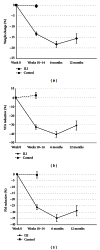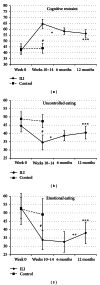Changes in body composition, cardiovascular disease risk factors, and eating behavior after an intensive lifestyle intervention with high volume of physical activity in severely obese subjects: a prospective clinical controlled trial
- PMID: 23710347
- PMCID: PMC3654355
- DOI: 10.1155/2013/325464
Changes in body composition, cardiovascular disease risk factors, and eating behavior after an intensive lifestyle intervention with high volume of physical activity in severely obese subjects: a prospective clinical controlled trial
Abstract
We examined the effects of a 10-14-weeks inpatient lifestyle modification program, including minimum 90 min of physical activity (PA) five days/week, on body composition, CVD risk factors, and eating behavior in 139 obese subjects (BMI 42.6 ± 5.2 kg/m²). Completion rate was 71% (n = 71) in the intensive lifestyle intervention (ILI) group and 85% (n = 33) among waiting list controls. Compared to controls body weight (-17.0 (95% CI: -18.7, -15.3) kg, P < 0.0001), fat mass (-15.2 (95% CI: -17.4, -13.1) kg, P < 0.0001), fat free mass (-1.2 (95% CI: -2.2, -0.2) kg, P = 0.016) and visceral fat (-86.6(95% CI: -97.4, -75.7) cm², P < 0.0001) were reduced in the ILI-group after 10-14 weeks. Within the ILI-group weight loss was -23.8 (95% CI: -25.9, -21.7) kg, P < 0.0001 and -20.3 (95% CI: -23.3, -17.3) kg, P < 0.0001, after six and 12 months, respectively. Systolic BP, glucose, triglycerides, and LDL-C were reduced, and HDL-C was increased (all P ≤ 0.006) after 10-14 weeks within the ILI group. The reduction in glucose and increase in HDL-C were sustained after 12 months (all P < 0.0001). After one year, weight loss was related to increased cognitive restraint and decreased uncontrolled eating (all P < 0.05). Thus, ILI including high volume of PA resulted in weight loss with almost maintenance of fat-free mass, favorable changes in CVD risk factors, and eating behavior in subjects with severe obesity.
Trial registration: ClinicalTrials.gov NCT01675713.
Figures






Similar articles
-
Beyond weight reduction: improvements in quality of life after an intensive lifestyle intervention in subjects with severe obesity.Ann Med. 2014 Aug;46(5):273-82. doi: 10.3109/07853890.2013.874660. Epub 2014 Feb 4. Ann Med. 2014. PMID: 24491067 Clinical Trial.
-
Arterial stiffness, lifestyle intervention and a low-calorie diet in morbidly obese patients-a nonrandomized clinical trial.Obesity (Silver Spring). 2013 Apr;21(4):690-7. doi: 10.1002/oby.20099. Obesity (Silver Spring). 2013. PMID: 23712971 Free PMC article. Clinical Trial.
-
Physical activity support or weight loss counseling for nonalcoholic fatty liver disease?World J Gastroenterol. 2014 Aug 7;20(29):10128-36. doi: 10.3748/wjg.v20.i29.10128. World J Gastroenterol. 2014. PMID: 25110440 Free PMC article.
-
[The "problem obesity": viewpoint of the internist].Ann Ital Chir. 2005 Sep-Oct;76(5):407-11. Ann Ital Chir. 2005. PMID: 16696212 Review. Italian.
-
The Look AHEAD Trial: Implications for Lifestyle Intervention in Type 2 Diabetes Mellitus.Prog Cardiovasc Dis. 2015 Jul-Aug;58(1):69-75. doi: 10.1016/j.pcad.2015.04.002. Epub 2015 Apr 30. Prog Cardiovasc Dis. 2015. PMID: 25936906 Free PMC article. Review.
Cited by
-
Toward a Romanian version of the Three-Factor Eating Questionnaire-R21 for children and adolescents (CTFEQ-R21): Preliminary psychometric analysis and relation with body composition.Dev Period Med. 2019;23(1):45-53. doi: 10.34763/devperiodmed.20192301.4553. Dev Period Med. 2019. PMID: 30954981 Free PMC article.
-
A dissonance-based intervention for women post roux-en-Y gastric bypass surgery aiming at improving quality of life and physical activity 24 months after surgery: study protocol for a randomized controlled trial.BMC Surg. 2018 May 9;18(1):25. doi: 10.1186/s12893-018-0358-7. BMC Surg. 2018. PMID: 29743040 Free PMC article. Clinical Trial.
-
Gender differences in coronary artery disease: correlational study on dietary pattern and known cardiovascular risk factors.Int Cardiovasc Res J. 2013 Dec;7(4):124-9. Epub 2013 Dec 1. Int Cardiovasc Res J. 2013. PMID: 24757636 Free PMC article.
-
A Nutritional Counseling Program Prevents an Increase in Workers' Dietary Intake and Body Weight During the COVID-19 Pandemic.Front Physiol. 2021 Jul 21;12:703862. doi: 10.3389/fphys.2021.703862. eCollection 2021. Front Physiol. 2021. PMID: 34366892 Free PMC article.
-
Healthcare Professionals' Perspectives of Nonsurgical Care of Older Inpatients with Class II or III Obesity and Comorbidities: A Qualitative Study.J Multidiscip Healthc. 2023 Nov 8;16:3339-3355. doi: 10.2147/JMDH.S421520. eCollection 2023. J Multidiscip Healthc. 2023. PMID: 38024134 Free PMC article.
References
-
- McTigue K, Larson JC, Valoski A, et al. Mortality and cardiac and vascular outcomes in extremely obese women. Journal of the American Medical Association. 2006;296(1):79–86. - PubMed
-
- Stiegler P, Cunliffe A. The role of diet and exercise for the maintenance of fat-free mass and resting metabolic rate during weight loss. Sports Medicine. 2006;36(3):239–262. - PubMed
Publication types
MeSH terms
Associated data
LinkOut - more resources
Full Text Sources
Other Literature Sources

